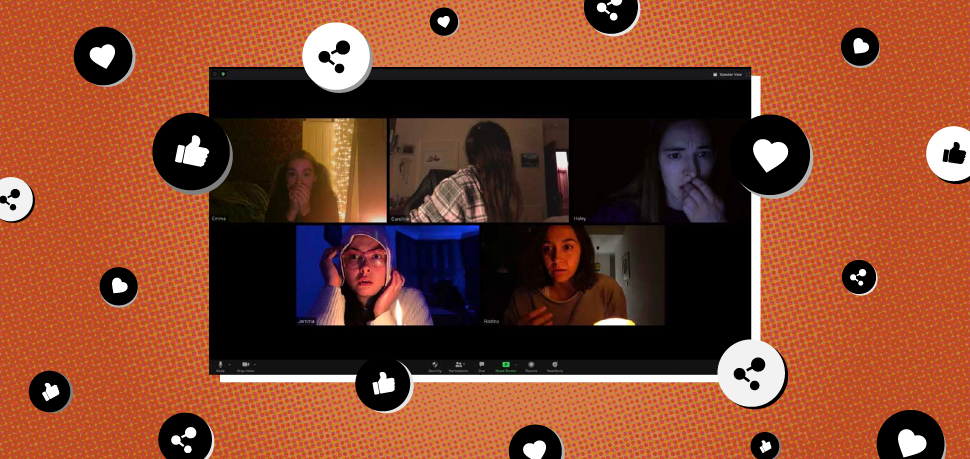
Everyone wants to make viral content. But how?
Well, let's start with this: The team here at Roger West are pretty big Halloween fans. We throw an annual costume contest. We look for excuses to write about scary things. We’re known to watch classic slashers and share taco boxes during lunch breaks.
Heck, even our brand colors are Halloween friendly. So, when we were throwing together our content calendar for the spookiest month of the year, we couldn’t resist the urge to talk about horror films and marketing.
On July 30, 2020, amid the coronavirus pandemic, horror streaming service Shudder released Host – a paranormal found footage film that was written, filmed, produced, and distributed during the initial COVID-19 lockdown.
Coincidentally, this film about life in a pandemic went viral. So, how did this small independent film make waves on social media and earn itself a 100% on the Tomatometer?
Let’s discuss.
What Does it Mean to Go “Viral”?
It’s 2020, so nobody wants to hear the term “viral” - but it’s not always a bad thing. Especially for marketers and content creators. Viral content describes content that generates a high level of awareness, exposure, and shares across the internet.
Videos are the medium most likely to achieve viral status, though this moniker can be extended to memes, images, social posts, and any other form of content posted to the web.
Viral content can do big things for its creators, especially when it comes to brand awareness, website traffic, and engagement – which is precisely why marketers are constantly trying to chase the big white whale of virality.
Viral marketing has since become a strategy of its own, though it’s more difficult to produce viral content than it seems. Creating viral content may be simple, but it’s far from easy.
Many have tried to find the secret sauce of viral content and viral marketing, to no avail.
Luckily, instances of commercial and viral success, such as the case of Host, help shed a light on what makes things catch fire on the internet and spread scary fast.,/p>
What does all viral content have in common?
- Broad Appeal: “David After Dentist” appeals to a global audience by featuring a bite-sized clip of cute kid after a laborious dental procedure. This is the silly side of the human experience.
- Creativity: Charlie Schmidt’s Keyboard Cat creatively combines simple, seemingly unrelated concepts like cats, music and miniature clothing to create 54 seconds of pure bliss.
- Proper Platform: SNL’s “Lazy Sunday” video benefitted from the perfect platform storm by being introduced to SNL viewers before getting posted on the new and unsaturated YouTube search engine, ensuring it wouldn’t get lost in the crowd.
- Timing (and a touch of luck): Nathan Apodaca aka Ocean Spray Guy went viral on TikTok after posting a video of himself skateboarding while drinking Ocean Spray and listening to Fleetwood Mac’s “Dreams”. It’s a feel-good video released in times of high stress, but luck certainly played a hand in its rapid transmission.
Host checks off almost all the boxes of what marketing experts would consider to be the holy trinity of any viral content recipe:
- Appeals to target audience (and beyond!)
- Employs creativity, innovation, and clearly defined visuals
- Right time, right place
Cultural Relevance
Host arguably became the first and most successful film to integrate COVID-19 into the plot, without making it a focal point, treading the line between relatability and escapism.
Society has used horror films to contextualize and confront their fears since the spawn of the genre – but Host took this a step further. Rather than using the looming pandemic as the source of horror, it made pandemic life part of the characters’ everyday narrative.
By normalizing things like socially distanced hangouts and masks, the filmmakers were able to create more grounded characters that held a broad appeal, reaching even those who weren’t diehard fans of their genre.
Creative Execution
Host weaponized the pandemic’s only safe space, online hangouts, by inviting a demonic presence into the homes of its characters.
This creative spin on paranormal games gone wrong speaks to our cultural reliance on Big Tech and the potential dangers of it, but it also furnishes an old-fashioned good time.
Defying the Odds
Timing is the most elusive and uncontrollable element of viral content. More often than not, it comes down to the right time, right place.
Host hit when viewers needed something new and it delivered. It also landed in the right place, on Shudder. The horror streaming platform is known for its carefully curated horror and thriller selections – sending Host to the screens of those destined to love it.
Horror fans devoured the movie and took to social media to spread the love, enticing other audiences to check it out on the reasonably priced and easily accessible Shudder app.,/p>
We Can Only Know What We Don’t Know
The truth about viral content is that sometimes it can’t be explained. Though marketers have tried for years to develop a fool-proof formula for virality, there haven’t been many consistent results.
Beyond being able to recognize the relevance, creativity, and timeliness of viral content – there is still much to learn on how to make it happen … but that shouldn’t stop you from trying to create top-notch content all year round.
It should only encourage you to keep developing your content library to spread awareness, increase engagement, and keep your customers coming back for more.
If you’re not sure where to start with your content – Roger West can help.

